List of Hindu pilgrimage places as per Hindu scriptures
Namaste friends, how are you doing today? Welcome to #BhagavanBhakthi website / blog.
Bhagavan Lord Sri Krishna blessings to you and your family!
In this website / blog, you will always learn about #Hinduism #Sanskrit language.
Also subscribe to my YouTube channel from this link #BhagavanBhakthi to view videos about #Hinduism #Sanskrit language.
Just before moving towards to know about “List of Hindu pilgrimage places as per Hindu scriptures“, let us know few basic and important information.
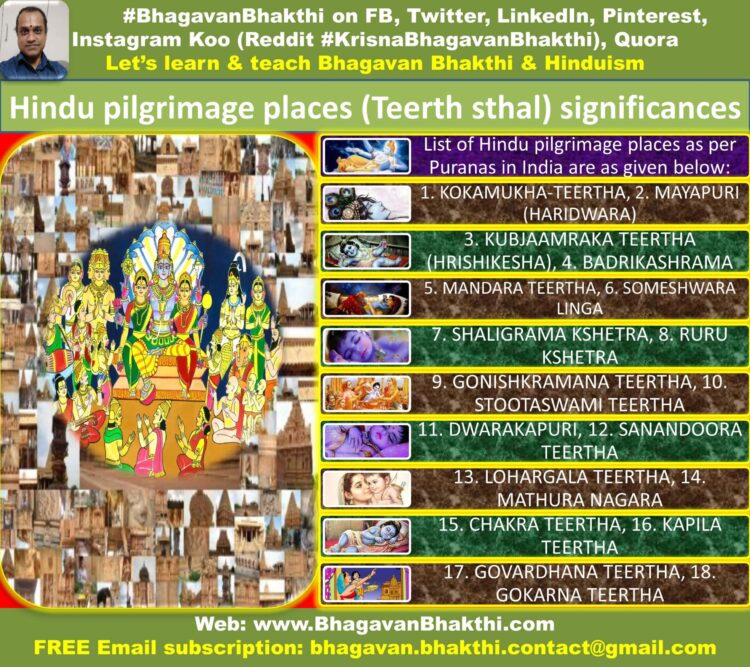
India (Bharata / Bharat), just name is enough for anyone to get it’s introduction.
Our ancestors have given us such great pilgrimage places that just thinking of those pilgrimage places is enough for us to gain the mukti / moksha (divine liberation).
Just visualizing those names and places will gain us all the material and spiritual things.
Starting from Bhagavan Sri Hari’s pilgrimages places, we have pilgrimage places for all the Demigods also all over India.
Starting from Jammu & Kashmir up to Kanyakumari and starting from Gujarat up to Arunachal Pradesh we are completely filled with divine pilgrimage places.
Now let us know few such kind of divine pilgrimages places which are located in India.
The following is taken from Varaha Purana.
Here Lord Varaha himself explains about the following teerthas (pilgrimage places) to his wife Prithvi Devi or BhooDevi (Mother Earth.
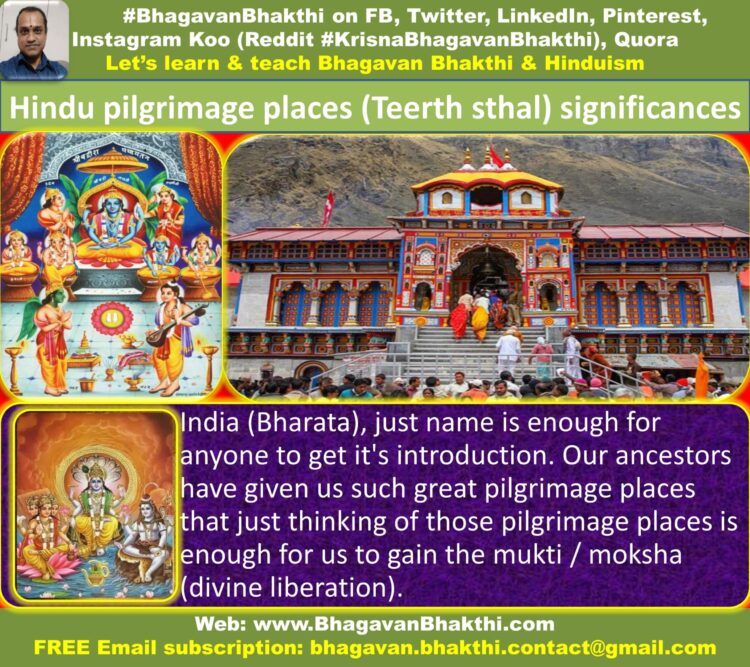
List of Hindu pilgrimage places as per Hindu scriptures are as given below:
1. KOKAMUKHA-TEERTHA
2. MAYAPURI (HARIDWARA)
3. KUBJAAMRAKA TEERTHA (HRISHIKESHA)
4. BADRIKASHRAMA
5. MANDARA TEERTHA
6. SOMESHWARA LINGA
7. SHALIGRAMA KSHETRA
8. RURU KSHETRA
9. GONISHKRAMANA TEERTHA
10. STOOTASWAMI TEERTHA
11. DWARAKAPURI
12. SANANDOORA TEERTHA
13. LOHARGALA TEERTHA
14. MATHURA NAGARA
15. CHAKRA TEERTHA
16. KAPILA TEERTHA
17. GOVARDHANA TEERTHA
18. GOKARNA TEERTHA
Now, let us know the significance of the about pilgrimage places (teerth sthal):
KOKAMUKHA-TEERTHA
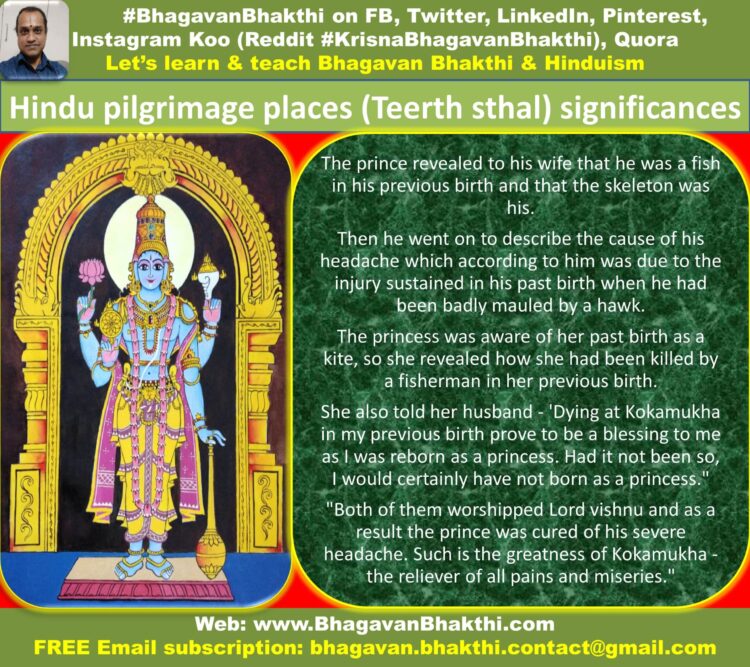
Describing the holiness of Kokamukha-teerth, Lord Varaha narrated a tale to Prithvi –
“Once, a fisherman was trying to catch a large fish in a lake situated at Kokamukha. Suddenly, a hawk which was flying in the sky, descended down and after picking the fish in it’s beak tried to fly away.”
“But, as the fish was a large one, the hawk could not hold it for too long.”
“As a result, the hawk fell on the ground being unable to bear the weight of the fish. But amazingly, the hawk turned into a handsome prince as soon as it touched the ground.”
“In the meantime, the fisherman’s wife arrived there carrying some meat-pieces in her hand. A kite, which was flying in the sky tried to snatch those meat-pieces.”
“Seeing this, the fisherman killed that kite with one shot of his arrow. In course of time, the kite took rebirth as a princess of Chandrapura.”
“She was extremely beautiful but hated men. Similarly, the fish was reborn as a prince. As the destiny would have liked it, both of them got married.”
“There was a dramatic change in the attitude of the princess after the marriage as she no longer hated men.”
“On the contrary, she loved her husband so much that she dreaded the thought of separation for even a moment.”
“One day, the prince had a severe headache which showed no sign of subsiding. The princess became very worried and summoned the royal physician.”
The physician left no stone unturned to cure his royal physician but without any success.
Somehow, the prince remembered everything about his previous birth and had a firm belief that he would be cured of his illness once he reached Kokamukha-the sacrosanct place of pilgrimage.
So he decided to go there accompanied by the princess.”
“Both of them reached a place at Kokamukha where they saw the remains (skeleton) of a fish lying on the ground.
The prince revealed to his wife that he was a fish in his previous birth and that the skeleton was his.
Then he went on to describe the cause of his headache which according to him was due to the injury sustained in his past birth when he had been badly mauled by a hawk.
The princess was aware of her past birth as a kite, so she revealed how she had been killed by a fisherman in her previous birth.
She also told her husband – ‘Dying at Kokamukha in my previous birth prove to be a blessing to me as I was reborn as a princess.”
“Had it not been so, I would certainly have not born as a princess.”
“Both of them worshipped Lord vishnu and as a result the prince was cured of his severe headache. Such is the greatness of Kokamukha – the reliever of all pains and miseries.”
MAYAPURI (HARIDWARA)
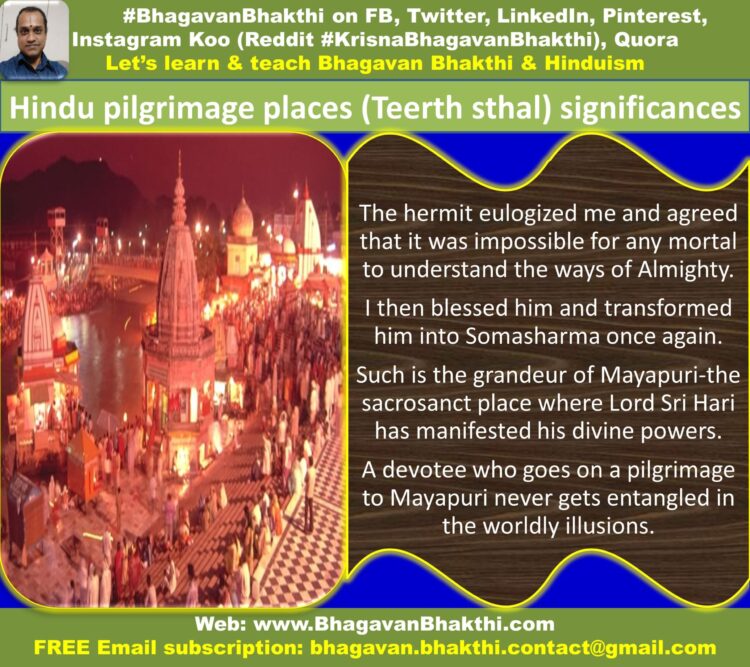
Narrating about the sanctity of Mayapuri, Lord Varaha told Prithvi – “There lived a brahmin named Somasharma at Mayapuri.
He was a great devotee of mine (Lord Sri Hari) and had an impossible desire of witnessing my divine powers by his mortal eyes.
I tried to make him understand about the futility of his desire but to no avail.
Finally I was left with no option but to fulfil his wish. One day Somasharma had gone to take his bath in the holy Ganges.
Hardly had he taken a dip than he found himself experiencing the pangs of birth in the womb of a nishada woman.
Evidently, Lord Sri Hari had began giving a glimpse of his divine powers to Somasharma.
It was a terrible experience for him and he vowed to lead a chaste life as soon as he came out of the womb.”
“Unfortunately, he forgot everything about his vow once he took rebirth as a girl.
In course of time, the girl grew up and married a young nishada. She had many children from him.
One day, the nishada girl who in reality was Somasharma, went to take a bath in the holy Ganges. As soon as she entered into the river, she got transformed into a hermit.
She was filled with extreme bewilderment but this was not the end, as there were more surprises to come.”
“The hermit (previously nishada and originally Somasharma) came out of the river and looked all around in amazement.
He then sat down to meditate and very soon he was engrossed in his meditation.
In the evening, some sages arrived and said – ‘Sir! how come you are sitting here?
You had gone to take a bath. We became anxious and started searching for you when you did not return till evening.”
“The hermit was bewildered by the turn of events as he was aware of every incident that had occurred.
He was also well aware that he had spent fifty years as nishada-woman but according to the statements of hermits he had been absent only for few hours.
The hermit was totally confused about his real identity. I (Lord Varaha) felt pity on his miserable condition and decided to lift my magic spell.
I asked him whether his wish of witnessing my divine powers had been fulfilled or not.
The hermit eulogized me and agreed that it was impossible for any mortal to understand the ways of Almighty.
I then blessed him and transformed him into Somasharma once again.”
Such is the grandeur of Mayapuri-the sacrosanct place where Lord Sri Hari has manifested his divine powers.
A devotee who goes on a pilgrimage to Mayapuri never gets entangled in the worldly illusions.
KUBJAAMRAKA TEERTHA (HRISHIKESHA)
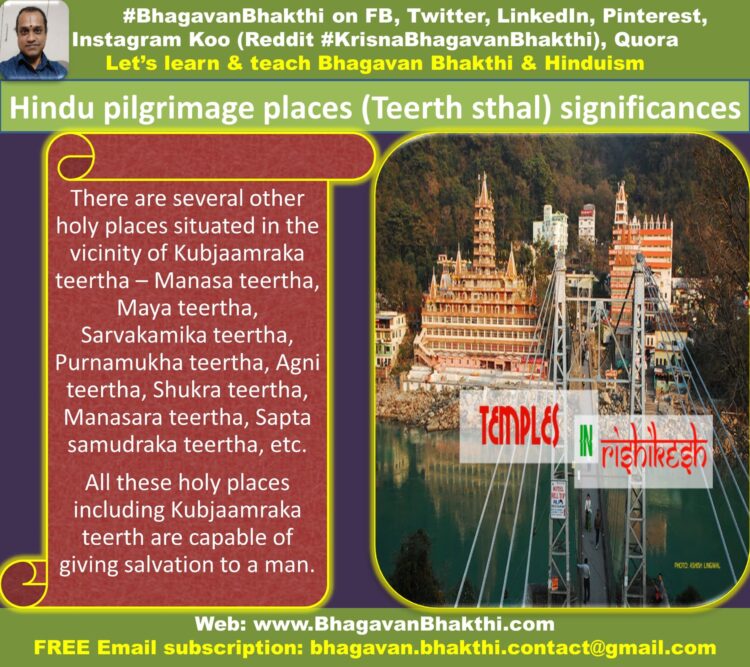
Describing how Kubjaamraka teertha derived it’s name, Lord Varaha told Prithvi –
“In satyayuga, at the time when the earth was still submerged in water, I had killed two mighty demons named Madhu and Kaitabha.
After killing both the demons I looked all around and found sage Raimya engrossed in his penance. Sage Raimya was a great devotee of mine.
I was extremely impressed and watched him hiding myself behind a mango tree.
The mango tree could not bear the weight of my hands and became curved.
This is how Kubjaamraka teertha derived it’s name.
Very soon, sage Raimya found out that I was hiding behind that mango tree.
He eulogized me and requested me to grant a special status to Kubjaamraka teertha among all the holy places.
I blessed him and thus Kubjaamraka teertha became one of the holiest places.
There are several other holy places situated in the vicinity of Kubjaamraka teertha – Manasa teertha, Maya teertha, Sarvakamika teertha,
Purnamukha teertha, Agni teertha, Shukra teertha, Manasara teertha, Sapta samudraka teertha, etc.
All these holy places including Kubjaamraka teerth are capable of giving salvation to a man.”
BADRIKASHRAMA
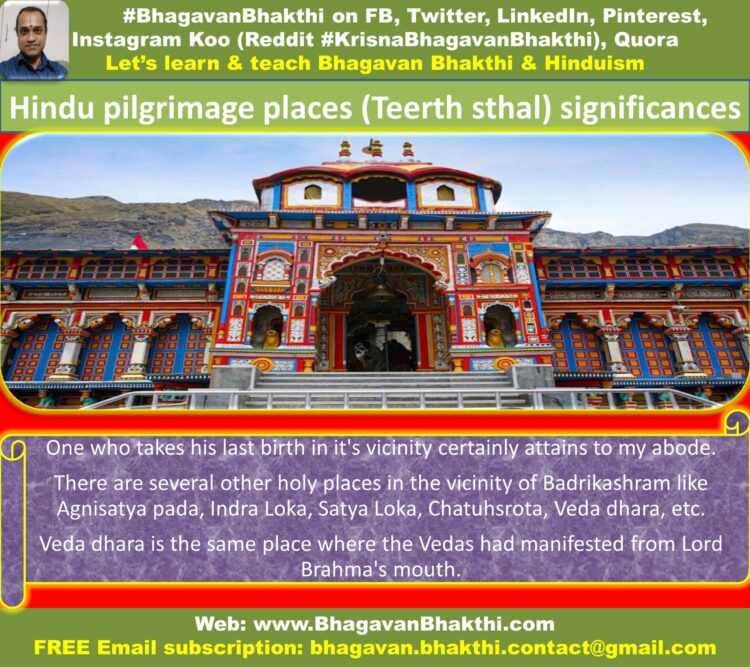
Continuing with his tale, Lord Varaha told Prithvi – “There is a sacred place in the Himalayas which is very inaccessible.
It is famously known as Badrikashram and holds an important place among all the holy places.
One who makes a pilgrimage to that place gets all his wishes fulfilled.
There is a reservoir at the mountain top called Brahma kunda.
One who observes fast for three consecutive nights and takes a holy dip in that reservoir attains virtues similar to “Agnishtom yagya”.
One who takes his last birth in it’s vicinity certainly attains to my abode.
There are several other holy places in the vicinity of Badrikashram like Agnisatya pada, Indra Loka, Satya Loka, Chatuhsrota, Veda dhara, etc.
Veda dhara is the same place where the Vedas had manifested from Lord Brahma’s mouth.
MANDARA TEERTHA
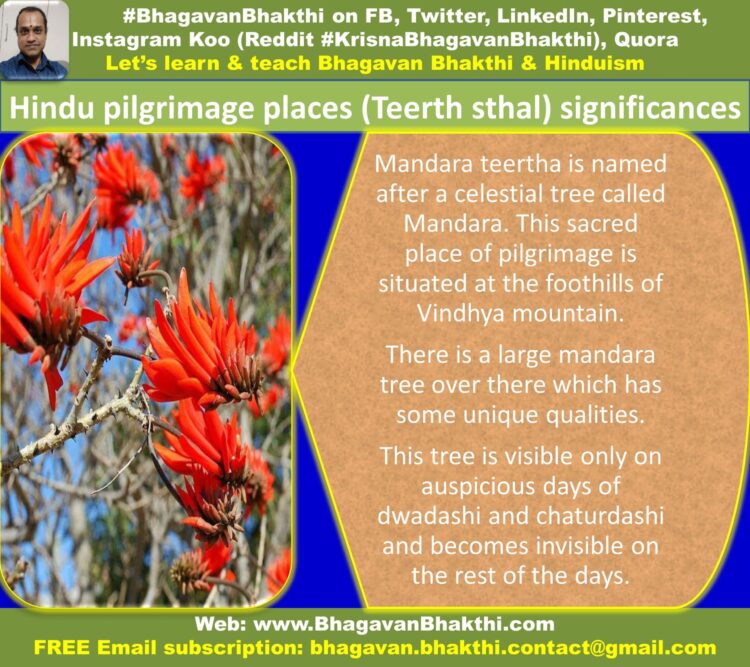
Mandara teertha is named after a celestial tree called Mandara. This sacred place of pilgrimage is situated at the foothills of Vindhya mountain.
There is a large mandara tree over there which has some unique qualities.
This tree is visible only on auspicious days of dwadashi and chaturdashi and becomes invisible on the rest of the days.
Some other holy places situated in the vicinity of mandara teertha are Prapana, Modana, Baikunthkarana, etc.
There is another holy place called mandara but it is situated on the Meru mountain. This holy place is also known as ‘Syamantapanchaka’.
One important characteristic of this holy place is that there are huge rocks resembling a mace, a wheel, a plough and a conch.
SOMESHWARA LINGA
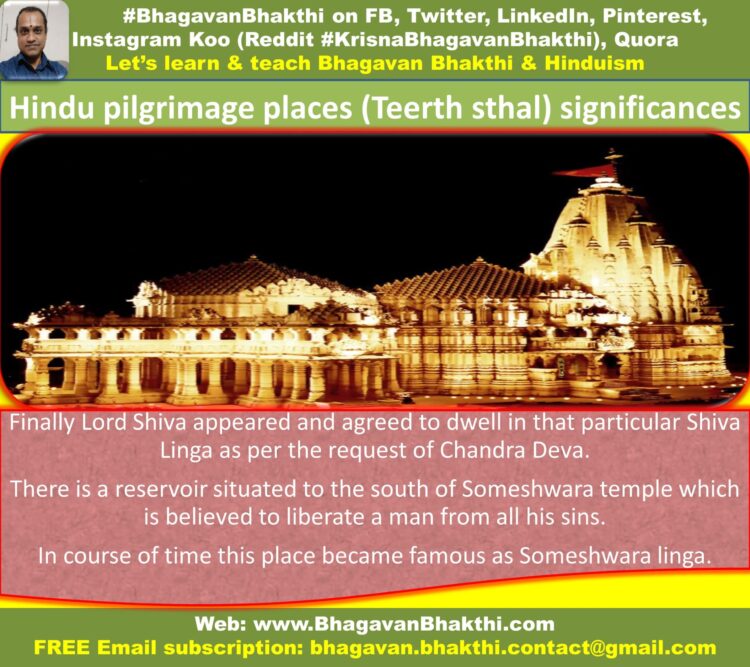
Chandra deva had once performed an austere penance to get absolved from the curse of his Daksha Prajapati his father-in-law.
During the course of his penance Chandra Deva made a Shiva Linga and worshipped it.
Finally Lord Shiva appeared and agreed to dwell in that particular Shiva Linga as per the request of Chandra Deva.
There is a reservoir situated to the south of Someshwara temple which is believed to liberate a man from all his sins.
In course of time this place became famous as Someshwara linga.
SHALIGRAMA KSHETRA
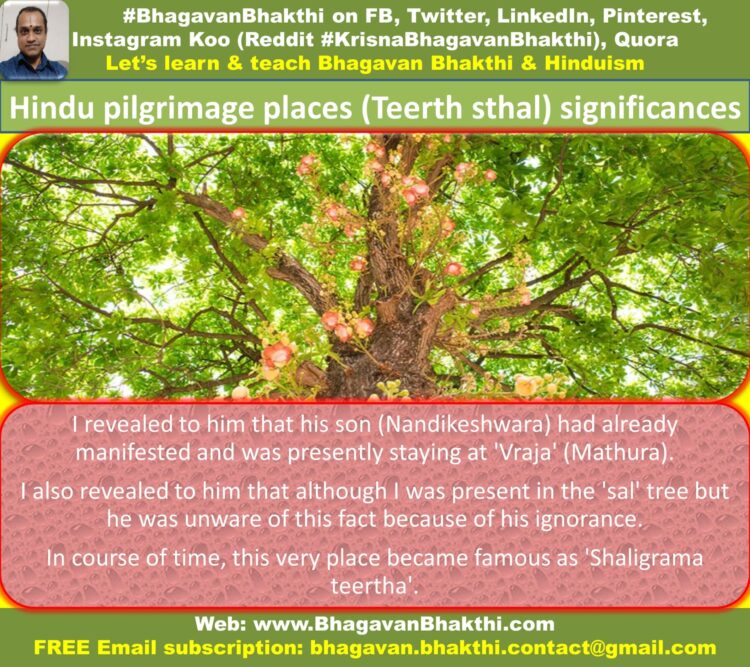
Prithvi requested Lord Varaha to shed light on the famous penance which sage Shalankayan had performed.
Lord Varaha narrated the following tale – “Long long ago sage Shalankayan did an austere penance to please me (Lord Vishnu).
There was a ‘sal’ tree nearby and the sage was ignorant of the fact that I dwell in that sacred tree.
When I appeared, he requested me to bless him with a divine son who had qualities like Lord Shiva.
I revealed to him that his son (Nandikeshwara) had already manifested and was presently staying at ‘Vraja’ (Mathura).
I also revealed to him that although I was present in the ‘sal’ tree but he was unware of this fact because of his ignorance.
In course of time, this very place became famous as ‘Shaligrama teertha’.
A devotee who makes a pilgrimage to this holy place is liberated from all kinds of worldly bondages.”
RURU KSHETRA
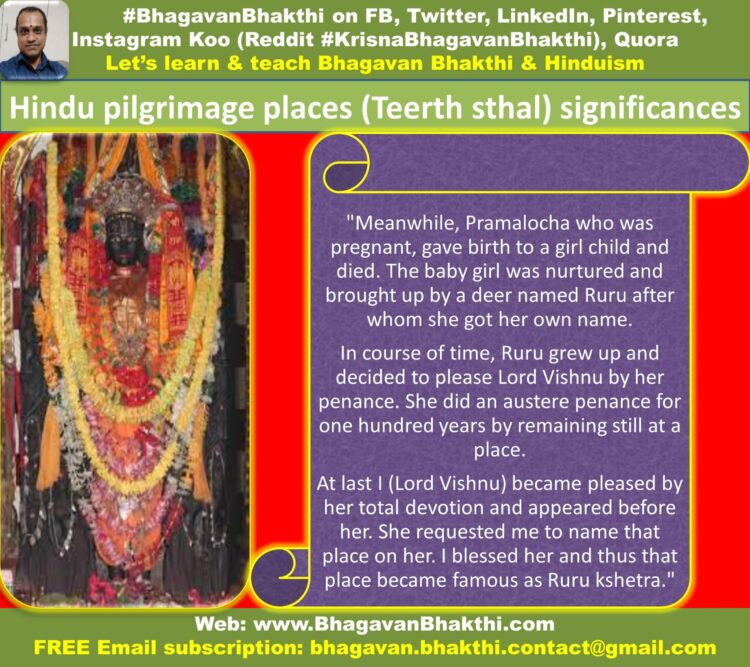
Lord Varaha told Prithvi – “This holy place is named after Ruru – the daughter of Devadutta and an apsara named Pramalocha.
Devadutta came from the lineage of sage Bhrigu. Once, Devadutta did an austere penance to please Lord Shiva.
His penance continued for ten thousand years. Indra became worried and sent a beautiful apsara named Pramalocha to disturb his penance.
Unfortunately, Devadutta fell into the trap laid by Indra. He was infatuated by Pramalocha’s divine beauty and enjoyed an intimate life with her for a long time.
Finally, he realized his mistake and regretted his foolishness. He decided to abandon Pramalocha and recommence his penance.
Ultimately, he was successful in pleasing Lord Shiva and attaining to Shiva Loka.”
“Meanwhile, Pramalocha who was pregnant, gave birth to a girl child and died.
The baby girl was nurtured and brought up by a deer named Ruru after whom she got her own name.
In course of time, Ruru grew up and decided to please Lord Vishnu by her penance. She did an austere penance for one hundred years by remaining still at a place.
At last I (Lord Vishnu) became pleased by her total devotion and appeared before her. She requested me to name that place on her. I blessed her and thus that place became famous as Ruru kshetra.”
GONISHKRAMANA TEERTHA
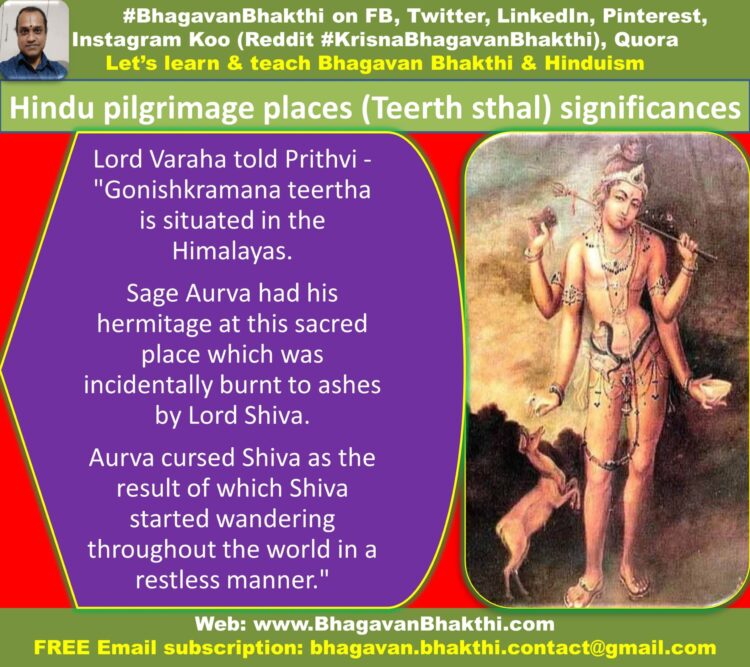
Lord Varaha told Prithvi – “Gonishkramana teertha is situated in the Himalayas.
Sage Aurva had his hermitage at this sacred place which was incidentally burnt to ashes by Lord Shiva.
Aurva cursed Shiva as the result of which Shiva started wandering throughout the world in a restless manner.”
“Once, Lord Shiva visited the hermitage of sage Aurvanam accompanied by his consort – Uma.
The purpose of the visit was to seek Aurvanama’s help in curing his restlessness. Sage Aurvanama advised him to have a bath with the milk of surabhi cow.
I (Lord Vishnu) then brought down seventy-seven surabhi cows from the heaven and thus helped Shiva take bath with their milk.
At last, Shiva’s restlessness came to an end and this holy place became famous as ‘Gonishkramana’ teertha.”
STOOTASWAMI TEERTHA
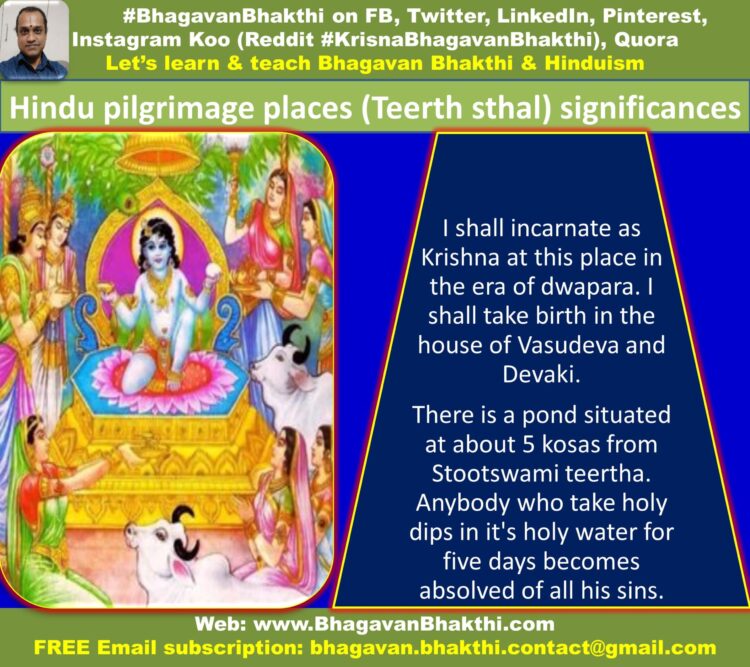
Lord Varaha then went on to describe the greatness of Stootswami teertha and told Prithvi –
“I shall incarnate as Krishna at this place in the era of dwapara. I shall take birth in the house of Vasudeva and Devaki.
There is a pond situated at about 5 kosas from Stootswami teertha. Anybody who take holy dips in it’s holy water for five days becomes absolved of all his sins.
DWARAKAPURI
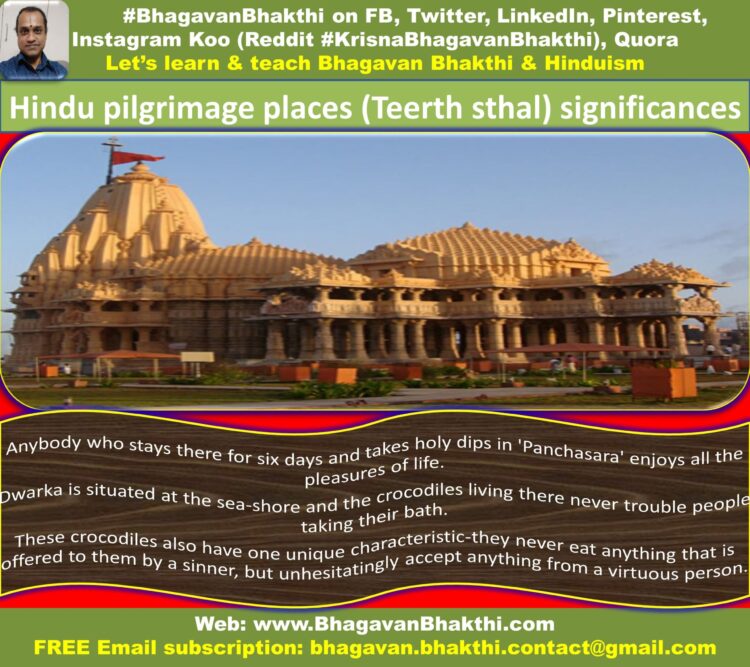
Lord Varaha told Prithvi – “There is a holy place called ‘Panchasara’ in Dwaraka.
Anybody who stays there for six days and takes holy dips in ‘Panchasara’ enjoys all the pleasures of life.
Dwarka is situated at the sea-shore and the crocodiles living there never trouble people taking their bath.
These crocodiles also have one unique characteristic-they never eat anything that is offered to them by a sinner, but unhesitatingly accept anything from a virtuous person.
There are several other holy places in and around Dwaraka-Panchapinda, Hansakunda, Hansateertha, Chakrateertha, Raivataka, Vishnu-sankarama, etc.
Vishnu sankarama is the very place where I, in my incarnation as Krishna would be killed by a hunter named Jara.
SANANDOORA TEERTHA
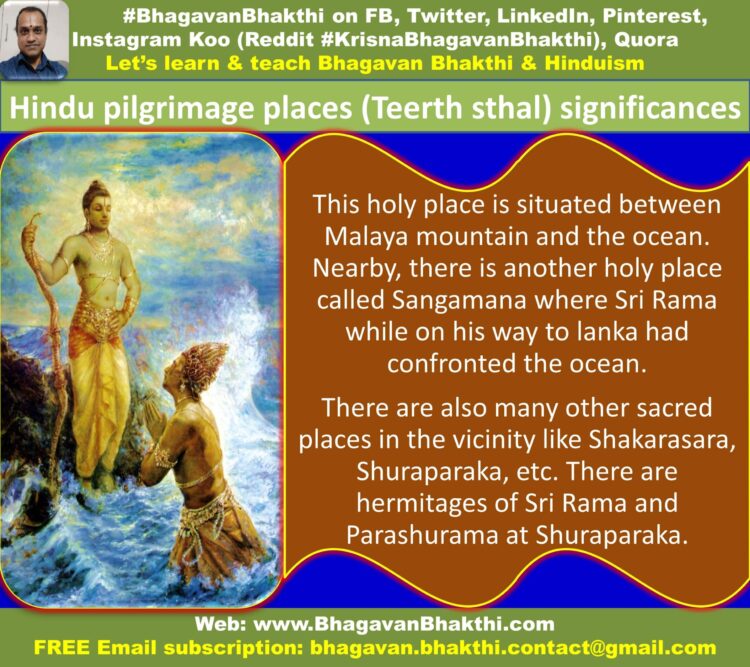
This holy place is situated between Malaya mountain and the ocean.
Nearby, there is another holy place called Sangamana where Sri Rama while on his way to lanka had confronted the ocean.
There are also many other sacred places in the vicinity like Shakarasara, Shuraparaka, etc.
There are hermitages of Sri Rama and Parashurama at Shuraparaka.
LOHARGALA TEERTHA
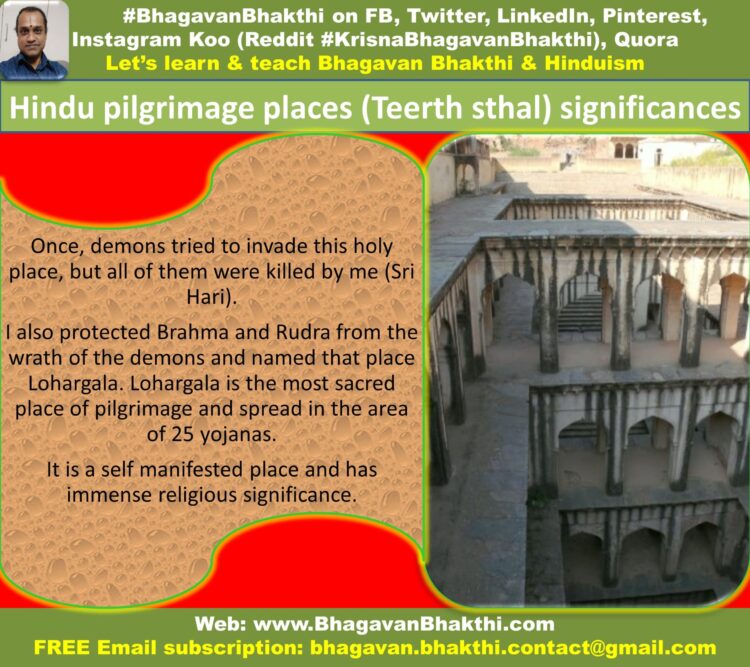
Lord Varaha told Prithvi – “There is a region inhabited by mlecchas, situated at the distance of some 30 yojanas.
This region is surrounded by Himalaya mountain in it’s central as well as southern parts.
Lohargala teertha is situated near this region and is well protected by nature which makes it very inaccessible.
Once, demons tried to invade this holy place, but all of them were killed by me (Sri Hari).
I also protected Brahma and Rudra from the wrath of the demons and named that place Lohargala.
Lohargala is the most sacred place of pilgrimage and spread in the area of 25 yojanas.
It is a self manifested place and has immense religious significance.
MATHURA NAGARA
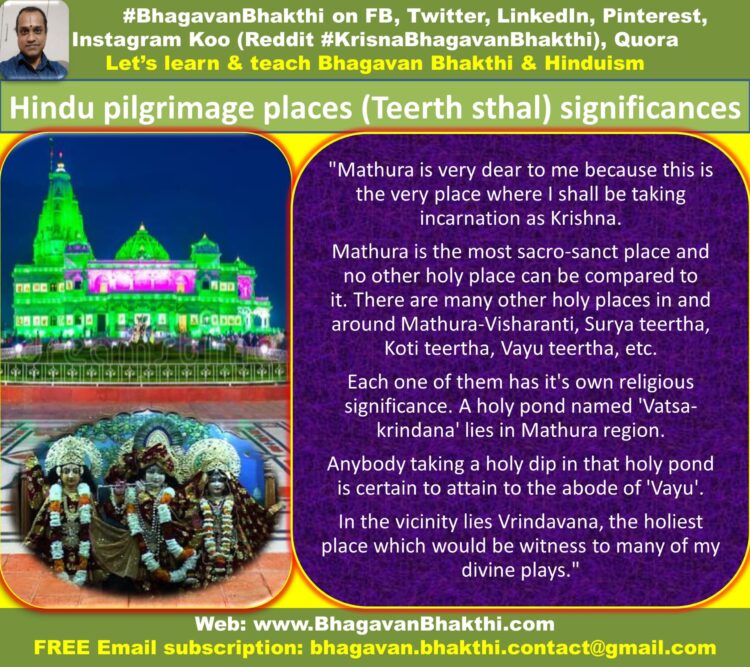
Describing the majesty of Mathura, Lord Varaha told Prithvi – “Mathura is very dear to me because this is the very place where I shall be taking incarnation as Krishna.
Mathura is the most sacro-sanct place and no other holy place can be compared to it.
There are many other holy places in and around Mathura-Visharanti, Surya teertha, Koti teertha, Vayu teertha, etc.
Each one of them has it’s own religious significance. A holy pond named ‘Vatsa-krindana’ lies in Mathura region.
Anybody taking a holy dip in that holy pond is certain to attain to the abode of ‘Vayu’.
In the vicinity lies Vrindavana, the holiest place which would be witness to many of my divine plays.”
CHAKRA TEERTHA
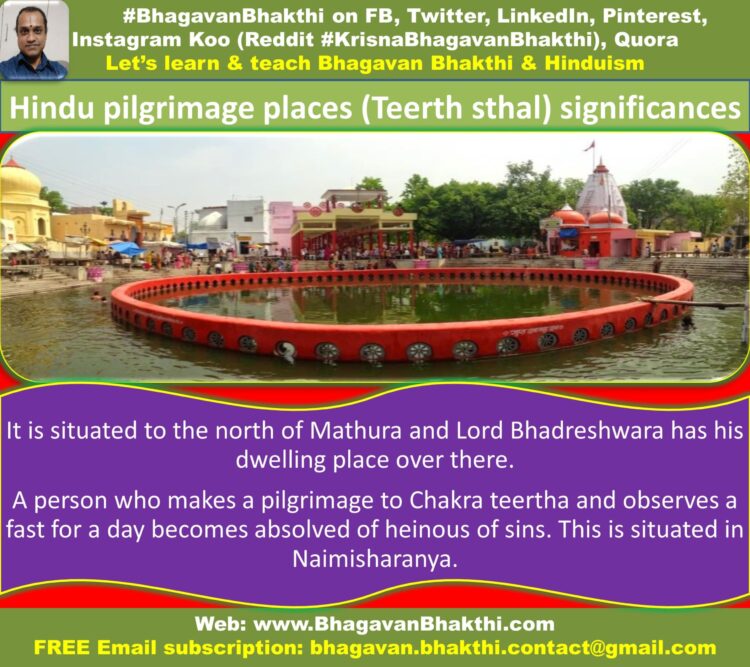
It is situated to the north of Mathura and Lord Bhadreshwara has his dwelling place over there.
A person who makes a pilgrimage to Chakra teertha and observes a fast for a day becomes absolved of heinous of sins. This is situated in Naimisharanya.
KAPILA TEERTHA
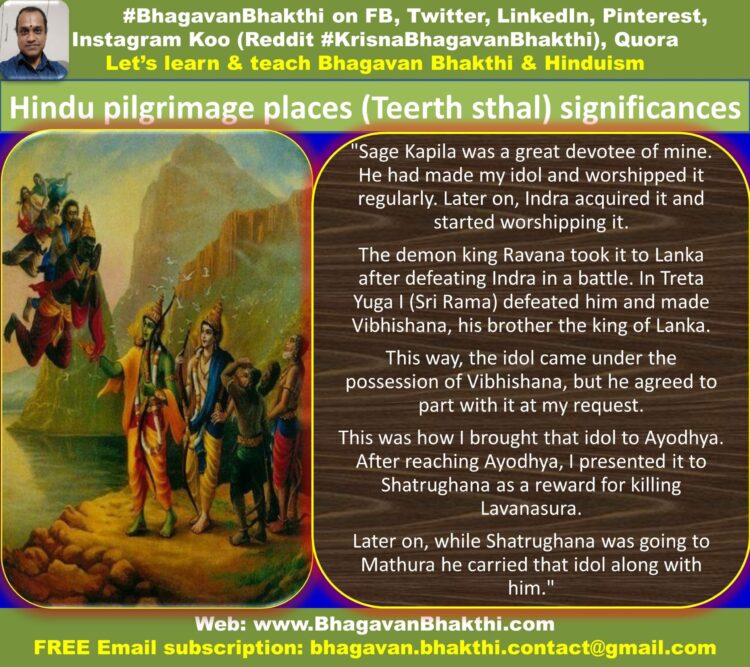
Describing the origin of ‘Kapila Varaha’ (an idol of Lord Varaha made by sage Kapila) Lord Varaha told Prithvi –
“Sage Kapila was a great devotee of mine. He had made my idol and worshipped it regularly.
Later on, Indra acquired it and started worshipping it.
The demon king Ravana took it to Lanka after defeating Indra in a battle.
In Treta Yuga I (Sri Rama) defeated him and made Vibhishana, his brother the king of Lanka.
This way, the idol came under the possession of Vibhishana, but he agreed to part with it at my request.
This was how I brought that idol to Ayodhya. After reaching Ayodhya, I presented it to Shatrughana as a reward for killing Lavanasura.
Later on, while Shatrughana was going to Mathura he carried that idol along with him.”
GOVARDHANA TEERTHA
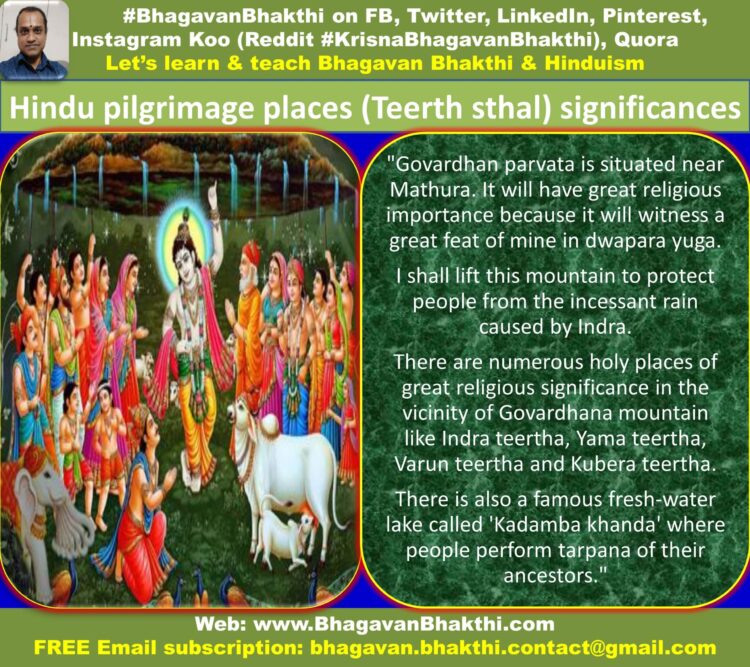
Lord Varaha, continuing with the description of various holy places told Prithvi about the magnificence of Govardhana parvata –
“Govardhan parvata is situated near Mathura. It will have great religious importance because it will witness a great feat of mine in dwapara yuga.
I shall lift this mountain to protect people from the incessant rain caused by Indra.
There are numerous holy places of great religious significance in the vicinity of Govardhana mountain like Indra teertha, Yama teertha, Varun teertha and Kubera teertha.
There is also a famous fresh-water lake called ‘Kadamba khanda’ where people perform tarpana of their ancestors.”
GOKARNA TEERTHA
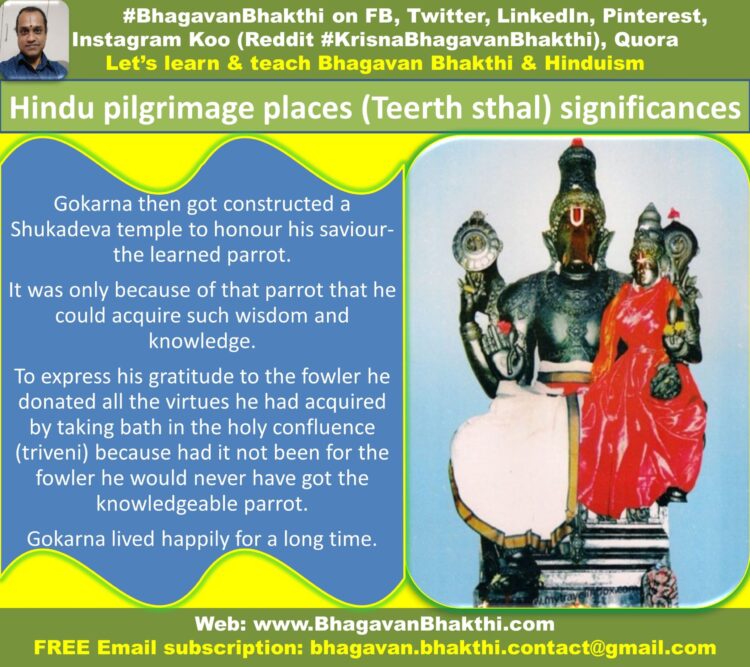
Lord Varaha told Prithvi about the greatness of Gokarna teertha – “Long long ago there lived a vaishya named Vasukarna at Mathura.
Sushila, his wife was deeply religious but inspite of that she was issueless.
One day, she had gone to take her bath in river Saraswati where she found many women taking their bath.
The children of these women were playing nearby. Sushila became very sad and being unable to control her emotions started crying.”
“A sage saw her crying and asked her as to what made her so sad. Sushila narrated her woeful tale to him.
The sage took pity on her and advised her to worship Lord Gokarna.
The sage said – ‘You will definitely be blessed with a son.’ Sushila went home and narrated the whole incident to her husband.
Both of them started worshipping Lord Gokarna Mahadeva with total devotion. After ten years, a son was born to them.
Vasukarna named that child after Lord Gokarna to express his gratitude to the deity.”
“In course of time, Gokarna grew up and got married but even after a long time he did not have a progeny.
So, his father married him to three more women, one after another, but even this did not prove to be of any help to Gokarna because he remained a sonless person.
This made Gokarna very sad and he engaged himself in various charitable activities thinking that the virtues thus attained might bless him in begetting a son.
He got constructed many temples and ordered wells to be dug up for the benifit of the travelers.
Very soon, all his money was spent and he became worried about the future of his family.
So, he decided to go to distant places to earn wealth.” “Once, while on his journey he met a divine parrot who possessed tremendous knowledge.
Gokarna was very much impressed by the parrot’s knowledge. He asked the parrot from where had it imbibed such divine knowledge.
The parrot revealed to him that he was Shukodara in it’s previous birth and was a learned man. He had attained the form of parrot due to the curse of sage Shukadeva.
But, sage Shukadeva had been kind enough to allow him to retain all the knowledge in his next birth.
The parrot also told Gokarna how it had been kept inside a cage by a fowler and requested him to help it out from the captivity.”
“Gokarna requested the fowler to give the learned parrot to him. The fowler agreed but asked for all the virtues attained by Gokarna in return.
Gokarna happily agreed to donate all his virtues and proceeded with that parrot. Now, Gokarna had become bereft of all his virtues he had attained so far.
Once, while he was on a voyage in connection with his trade the ship was caught in a severe cyclone and the chances of survival looked very bleak.
All his fellow travellers had a misconception that they had been struck by the misfortune only because of Gokarna’s sins.
The parrot was saddened after hearing what people said about his master. It decided to help him and flew away towards north.
While flying it found a Vishnu temple where many divine women and other creatures had gathered to worship.
The descendants of Jatayu were also among them. The parrot narrated the woeful tale of his master to all of them.
All the divine birds decided to help Gokarna.”
“The divine birds instructed the parrot to follow them and then flew towards the place where Gokarna’s ship was stranded.
Finally, they were successful in rescuing Gokarna and bringing him back to the same temple.
Gokarna worshipped Lord Keshava and performed the rituals of tarpana in the name of his ancestors.
In the meantime, all the divine women also arrived there to worship. They were pleased to meet Gokarna and gave him divine food to eat.
They also allowed him to stay there for as long as he wished.”
“Meanwhile the ship managed to reach the sea shore. Gokarna’s companions met his parents and narrated the whole incident to him.
Gokarna’s parents were filled with sorrow at the fate of their son.
On the other hand, Gokarna continued to live in that temple for a long period.
He was worried about his father as it had been a long time since he saw him.
He sent the parrot to bring his news. The parrot flew away to Mathura and met his father-Vasukarna.
Vasukarna thanked the parrot for saving his son’s life. The parrot then flew back on his return journey and gave the good news to Gokarna.”
“One day Gokarna found the divine ladies extremely sad.
When asked, they told him that the king of Ayodhya had destroyed the beautiful gardens of Mathura and this was the reason for their sadness.
Gokarna assured them that he would convince the king to abandon his evil plan if he got a chance to meet him.
The divine women then provided Gokarna with a divine aircraft boarded on which he reached Mathura.
Gokarna met the king and managed to convince him against destroying beautiful gardens.
The king was extremely impressed by his knowledge and presented great amount of wealth to him. This way all the divine women became happy once again.”
“Gokarna then went home and met his family members. His parents and his wives were very pleased to see him.
Gokarna then got constructed a Shukadeva temple to honour his saviour-the learned parrot.
It was only because of that parrot that he could acquire such wisdom and knowledge.
To express his gratitude to the fowler he donated all the virtues he had acquired by taking bath in the holy confluence (triveni) because had it not been for the fowler he would never have got the knowledgeable parrot.
Gokarna lived happily for a long time.”
Dear friends, if you need any clarifications about this post, kindly let me know, I will definitely try to answer all of them.
Also your one LIKE, one COMMENT, One Share, one SUBSCRIPTION is highly important.
This will help to know the quality of this content and also it will be helpful to know if any improvements is required for the content.
If you feel this content is useful to you and has helped you to improve your knowledge, kindly share this with your well-wishers.
Because “SHARING MEANS CARING”.
To receive FREE EMAIL SUBSCRIPTION about #BhagavanBhakthi, you can send an email to bhagavan.bhakthi.contact@gmail.com from your email ID.
NAMASTE!
Sri Gurubhyo Namaha
Sri Krishnaaya Namaha
Sri Krishnaarpanamastu
Subscribe / Follow us Share in Social Media